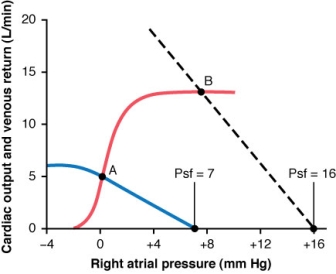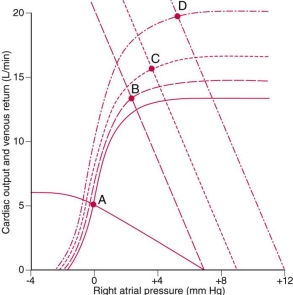Deck 20: Cardiac Output, Venous Return, and Their Regulation
سؤال
سؤال
سؤال
سؤال
سؤال
سؤال
سؤال
سؤال
سؤال
سؤال
سؤال
سؤال

فتح الحزمة
قم بالتسجيل لفتح البطاقات في هذه المجموعة!
Unlock Deck
Unlock Deck
1/12
العب
ملء الشاشة (f)
Deck 20: Cardiac Output, Venous Return, and Their Regulation
1
A 60-year-old woman in the intensive care unit has a large arteriovenous fistula. Her cardiac output is 10 L/min, oxygen consumption is 250 mL/min, and pulmonary vein oxygen concentration is 180 ml/L. What is the pulmonary artery oxygen concentration (in ml/L)?
A)145
B)155
C)165
D)185
E)205
A)145
B)155
C)165
D)185
E)205
B
2
In which of the following conditions would you expect a decreased resistance to venous return?
A)Anemia
B)Increased venous resistance
C)Increased arteriolar resistance
D)Increased sympathetic output
E)Obstruction of veins
A)Anemia
B)Increased venous resistance
C)Increased arteriolar resistance
D)Increased sympathetic output
E)Obstruction of veins
A
3
Which of the following is normally associated with an increased cardiac output?
A)Cardiac tamponade
B)Increased venous compliance
C)Moderate anemia
D)Severe aortic stenosis
E)Surgically opening the chest
A)Cardiac tamponade
B)Increased venous compliance
C)Moderate anemia
D)Severe aortic stenosis
E)Surgically opening the chest
C
4
A 40-year-old woman is hospitalized with severe anemia. This patient has a cardiac output of 12.5 L/min, oxygen consumption is 250 mL/min, and pulmonary artery oxygen concentration of 160 ml/L. What is the pulmonary vein oxygen concentration (in ml/L)?
A)140
B)150
C)160
D)180
E)200
A)140
B)150
C)160
D)180
E)200

فتح الحزمة
افتح القفل للوصول البطاقات البالغ عددها 12 في هذه المجموعة.
فتح الحزمة
k this deck
5
Which of the following statements about resistance to venous return (RVR) is true?
A)An increase in venous resistance causes an increase in RVR
B)Increased parasympathetic stimulation causes an increase in RVR
C)An increase in RVR causes an increase in venous return
D)Sympathetic inhibition causes an increase in RVR
E)Changes in arterial resistance have a greater effect on RVR than do equal changes in venous resistance
A)An increase in venous resistance causes an increase in RVR
B)Increased parasympathetic stimulation causes an increase in RVR
C)An increase in RVR causes an increase in venous return
D)Sympathetic inhibition causes an increase in RVR
E)Changes in arterial resistance have a greater effect on RVR than do equal changes in venous resistance

فتح الحزمة
افتح القفل للوصول البطاقات البالغ عددها 12 في هذه المجموعة.
فتح الحزمة
k this deck
6
Which of the following will usually increase the plateau level of the cardiac output curve?
A)Myocarditis
B)Severe cardiac tamponade
C)Decreased parasympathetic stimulation of the heart
D)Myocardial infarction
E)Mitral stenosis
A)Myocarditis
B)Severe cardiac tamponade
C)Decreased parasympathetic stimulation of the heart
D)Myocardial infarction
E)Mitral stenosis

فتح الحزمة
افتح القفل للوصول البطاقات البالغ عددها 12 في هذه المجموعة.
فتح الحزمة
k this deck
7
Which of the following conditions is normally associated with an increased mean systemic filling pressure?
A)Decreased blood volume
B)Increased venous compliance
C)Increased arterial compliance
D)Congestive heart failure
E)Hypothyroidism
A)Decreased blood volume
B)Increased venous compliance
C)Increased arterial compliance
D)Congestive heart failure
E)Hypothyroidism

فتح الحزمة
افتح القفل للوصول البطاقات البالغ عددها 12 في هذه المجموعة.
فتح الحزمة
k this deck
8
A patient with a resting cardiac output of 4 L/min is exercised maximally, increasing cardiac output to 8 L/min. What is the cardiac reserve?
A)250%
B)200%
C)150%
D)100%
E)50%
A)250%
B)200%
C)150%
D)100%
E)50%

فتح الحزمة
افتح القفل للوصول البطاقات البالغ عددها 12 في هذه المجموعة.
فتح الحزمة
k this deck
9
Which of the following normally causes the cardiac output curve to shift to the right along the right atrial pressure axis?
A)Changing intrapleural pressure to -6 mm Hg
B)Increasing mean systemic filling pressure
C)Taking a patient off a mechanical ventilator and allowing normal respiration
D)Surgically opening the chest
E)Breathing against a negative pressure
A)Changing intrapleural pressure to -6 mm Hg
B)Increasing mean systemic filling pressure
C)Taking a patient off a mechanical ventilator and allowing normal respiration
D)Surgically opening the chest
E)Breathing against a negative pressure

فتح الحزمة
افتح القفل للوصول البطاقات البالغ عددها 12 في هذه المجموعة.
فتح الحزمة
k this deck
10
Which of the following will elevate the plateau of the cardiac output curve?
A)Surgically opening the thoracic cage
B)Placing a patient on a mechanical ventilator
C)Cardiac tamponade
D)Decreasing parasympathetic stimulation of the heart
E)Decreasing sympathetic stimulation of the heart
A)Surgically opening the thoracic cage
B)Placing a patient on a mechanical ventilator
C)Cardiac tamponade
D)Decreasing parasympathetic stimulation of the heart
E)Decreasing sympathetic stimulation of the heart

فتح الحزمة
افتح القفل للوصول البطاقات البالغ عددها 12 في هذه المجموعة.
فتح الحزمة
k this deck
11
For the cardiac output curve defined by the solid line and the venous return curve defined by the dashed line (with equilibrium at point B), what is the resistance to venous return in units of mm Hg/L/min? 
A)1.70
B)1.40
C)1.23
D)0.65
E)0.35

A)1.70
B)1.40
C)1.23
D)0.65
E)0.35

فتح الحزمة
افتح القفل للوصول البطاقات البالغ عددها 12 في هذه المجموعة.
فتح الحزمة
k this deck
12
For the following cardiac output and venous return curves defined by the dashed lines (with the equilibrium at B), which of the following is true? 
A)Mean systemic filling pressure is 7 mm Hg
B)Right atrial pressure is 0 mm Hg
C)Resistance to venous return is 1.4 mm Hg/L/min
D)Pulmonary arterial flow is approximately 7 L/min
E)Resistance to venous return is 2.8 mm Hg/L/min

A)Mean systemic filling pressure is 7 mm Hg
B)Right atrial pressure is 0 mm Hg
C)Resistance to venous return is 1.4 mm Hg/L/min
D)Pulmonary arterial flow is approximately 7 L/min
E)Resistance to venous return is 2.8 mm Hg/L/min

فتح الحزمة
افتح القفل للوصول البطاقات البالغ عددها 12 في هذه المجموعة.
فتح الحزمة
k this deck








